What Forms Should Transitional Species Take?
The following chapters will be examining those still-living species that, evolutionists claim, represent transitional links and demonstrating that these are not transitional links at all, but rather unique, perfect and flawless living things possessed of all the features of a distinct species. First, however, it will be useful to consider what any such transitional links should be like—according to the predictions of the theory of evolution.
Recall how, according to the theory, any transitional link comes into being. External factors such as radiation and chemical effects cause changes in the living thing’s DNA. The result is mutations that lead to various physical, anatomical changes in that living organism. According to the theory of evolution, when a species is repeatedly subjected to mutations over the course of many generations, it may transform itself into another species altogether. Again—according to the theory—natural selection selects the most useful of such mutations, combines them and thus gradually creates an entirely new biological structure. That is a brief summary of the theory of evolution’s claim regarding the origin of species.
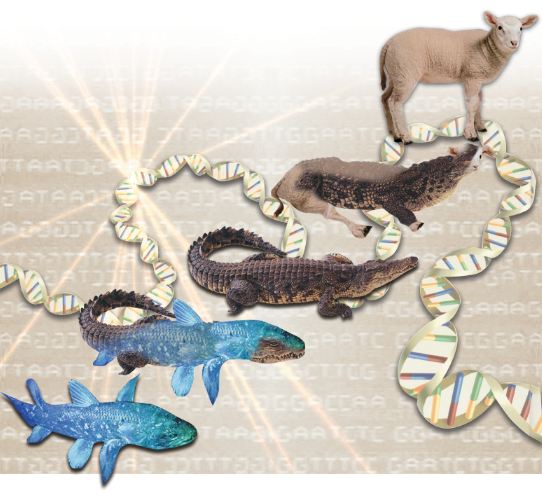 |
| According to the theory of evolution, species developed from one another by means of minute changes. If this claim by evolutionists were true, then transitional form creatures of the kind shown here should have been found. Yet there is not a trace of them. |
In reality, however, mutations occur at random and generally have detrimental effects on the living organism in which they occur. When they are not actually destructive, they have no beneficial effect at all. Not a single situation in which mutations do any good has yet been identified. For that reason, it is impossible for mutations to benefit a living species and improve its chances of breeding and passing along its altered genes. In particular, it is impossible for mutations to transform a different living species with new features in incremental stages, starting from the very simplest, without damaging that living thing’s overall structure or the flawlessness of its functions, and without making its viability considerably more difficult.
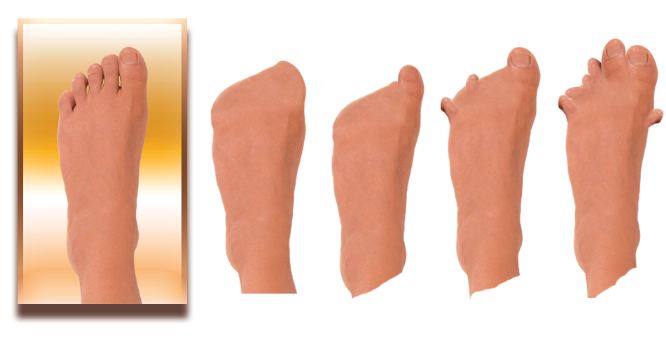 |
One of the millions ofcomplete foot forms encountered (picture: 5)
Defective transitional forms which should exist accordding to evolutionists,but which do not (Pictures: 1-4) |
Since mutations are random and unintentional, they cannot construct in a series of moves a lung to help a fish move from the sea to the land. Neither can they, either immediately or in gradual stages, turn that creature’s fins into legs to bear its weight on land or let it walk comfortably without lurching. As a result of mutations, oddly shaped, deformed structures will emerge—somewhere between gills and lungs, fins and legs, scales and feathers, feet and wings, a four-legged posture and an upright one, crippled and with a great many abnormalities..
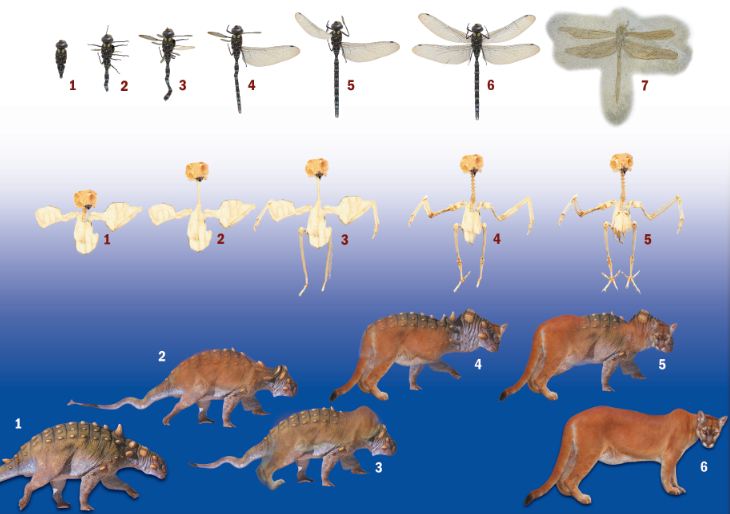 |
| Top: Evolutionists Maintain That Living Things Assumed Their Present Forms in steges.
Yet not a single axample of a transitional form has ever been found. (pictures: 1-5)
a present-day dragonfly with its flawless structure (picture: 6)
a dragonfly fossil,some 355-295 milion years old, is identical to present-day specimens. (picture: 7) Middle: Imaginary transitional forms which evolutionists claim must exist (pictures: 1-4)
All of the living things found in the fossil record are flawless and complete. None of them are at transitional stages, as shown in this picture. This fact is an important proof that evolution never took place.
a fossil of a complete bird (picture: 5) Bottom: Imaginary transitional forms, like those above, never existed. |
Moreover, evolutionists hypothesize that this process will last for millions of years. Therefore, the number of such deformed transitional individuals will be much greater than the number of completed species, and such in-between fossils should be those most frequently encountered. According to evolutionists’ claims, every species we see today, and right down to the finest detail, every structure within those species, from eye sockets to ankles, from the tiny bones which constitute the fingers to the shape of the skull, from the shape of the rib cage to the number of vertebra—all came about gradually as the result of random mutations. This means that every organ, limb, and component of the species was also formed in stages until the final form of that species emerged at last.
Consider the skull, for example. All the creatures today and all those that once lived in the past possess flawless, smooth, symmetrical skulls with no deformations at all. According to the claims of evolutionists, however, skulls must have gone through a great many tentative stages until the first flawless one emerged. Skulls would have to assume a large number of asymmetrical forms before taking on a symmetrical appearance. Until they did assume a symmetrical appearance, billions of imperfect forms would have been preserved—for example, a preponderance toward the right, the jaw pointing more right or left, the nose being nearer the mouth, one ear being further back on the skull than the other, one eye socket being higher and more to the left etc. Alternatively, a number of useless and unnecessary bones should appear on such skulls, only to vanish a few generations later, since they serve no purpose. Yet no such skulls appear in the fossil record. They are all perfect and symmetrical, just like present-day skulls. The spaces between apertures for such organs as the eyes, ears and nose are also symmetrical and regular.
As can be seen in the illustrations, all known skulls are fully formed and regular, displaying no transitional characteristics. No matter which species they belong to, all have perfect structures, with no appearance of being half-formed or incomplete. These skulls did not come into existence by chance mutations or retain features of any transition from one species to another, just like those of present-day living things. If the theory of evolution were true, then there should be fossils with the kinds of lopsided, shapeless and deformed skulls shown on the preceding page. Yet there is no trace of such fossils in any strata, anywhere in the world. This definitively disproves the theory of evolution’s claims.
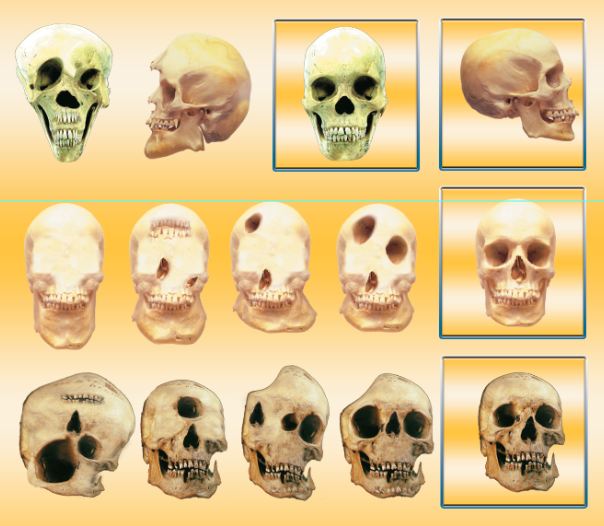 |
| Like thosen in frame,all known human skulls are symmetrical,regular and complete.
Contrary to evolutionists’ expectations,there is no trace in the fossil record of defective asymetrical skulls, like those without fraes and deliberately made. |
For a clearer idea of how many odd structures and peculiar transitional forms the fossil record should contain, we need to focus on the evolutionist concept of coincidence. According to the theory, transitional forms come into existence quite unconsciously, entirely by chance. For instance, a random mutation affects the genetic structure of a creature, and a number of changes take place in its body structure. However, this mutation does not alter the living thing’s genetic structure entirely. For instance, while its hind legs are affected, its skull may remain the same. Whichever genes the mutation may impact on, there will be a change only in the structure or organs controlled by those particular genes. This is a piecemeal fantasy that can never actually come about.
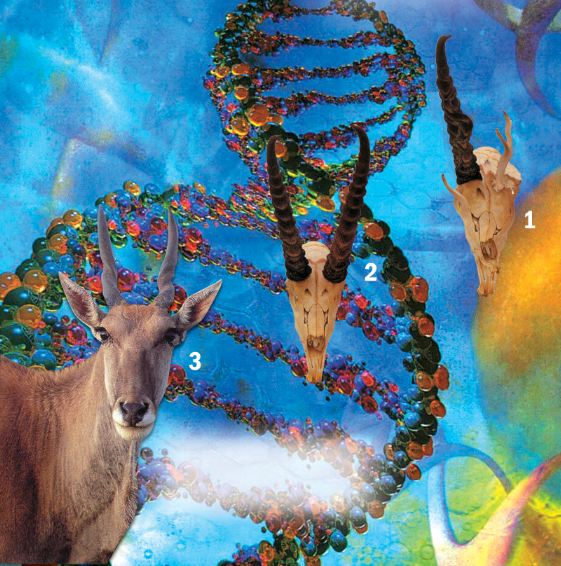 |
| 1-An imaginary antelope transitional form which does no tappear in the fossil record
2-A regular antelope skull
3-An antelope with complete, symmetrical and flawless horns skull If living things really had come into being as the result of random mutations, as evolutionists would have us believe, then until, say, a rhinoceros’ or deer’s horns emerged, there would have been countless deformed and odd-looking horns. These would inevitably appear in the fossil record. Yet all the horns in that record are fully and perfectly formed. |
As we know, all the features possessed by living things are concealed inside their DNA, which is analogous to an enclyclopedic data bank consisting of billions of units, or letters. Random mutations which affect those letters cannot make that information more useful because these mutations are devoid of conscious intent. For that reason, mutations will always corrupt data, not improve it.
 |
If the theory of evolution were true, then we should freouently encounter in the fossil record defective and peculiar hand and arm structures,of the kind shown.
Yet all the known hand and arm forms are exceptionally functional and regular... |
Mutations that arise unconsciously cannot form a new, flawless structure. They always give rise to deformed, lopsided and deficient ones. Human hands, according to the theory of evolution, are the work of random mutations—which actually cannot give rise to hands that are aesthetically pleasing, functional, able to sculpt statues, grasp, and feel.
Until they reach the most ideal level (something which mutations can never actually do), they must construct a sequence of deformed hands, arms, feet and legs. For instance, every finger needs to go through millions of phases before attaining its present length. According to evolutionists’ claims, every generation will attempt a large number of trial sequences to produce fingers from wrists until they are finally arranged in the correct order.
If you randomly flung Scrabble tiles with letters on them onto the board, you cannot expect them to line up in a regular order and create meaningful words, much less sentences. Neither can you expect random mutations to form hands of fingers, arm or leg bones, in any regular, functional and aesthetic order.
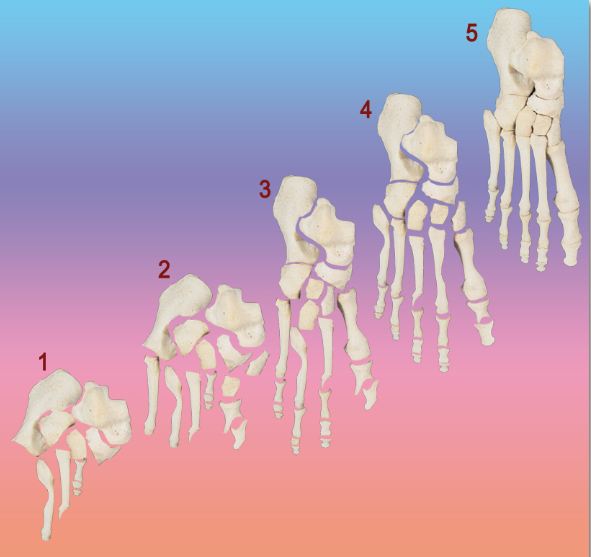 |
| Imaginry, defective foot bone structures not found anywere in the fossil record (pictures: 1-4)
A regular human foot bone (picture: 5) The imaginary, defective foot structures in shown above (pictures: 1-4) are of such a kind as to prevent a human being walking, or even standing upright. Yet all the known foot-bone fossils possess an ideal design. No abnormalities of this sort are encountered. |
For instance, the bones in your foot have been specially designed to let you walk in the most ideal, least tiring manner, and to keep to a minimum perception of your body’s weight. . The arch of your foot supports those bones against the weight of your body. For that reason, soles with “fallen arches” have difficulty in walking. If we accept the evolutionist claims as correct, foot bones would have to go through an infinite number of phases before reaching this ideal state. But in fact, fully formed and flawless feet always appear in the fossil record, and never mid-phase ones.
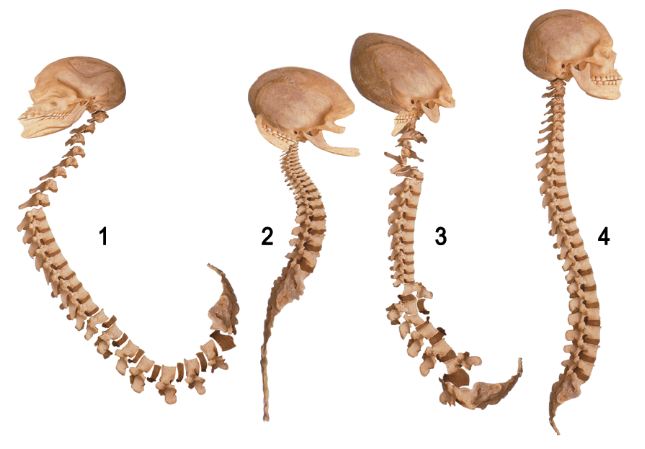 |
| Imaginary, defective backbone forms (picture: 1-3)
Actual Human Backbone (picture: 4) The real human backbone is exceedingly regular and possesses the ideal flexible design to keep the body upright. No trace is to be found of transitional-form backbones that evolutionists claim must have existed. |
According to evolutionists’ claims, malformed phases of a backbone should also be encountered in the fossil record. The human backbone consists of 33 small, round bones known as vertebra, set one above the other, and is of vital importance to any vertebrate, not just human beings. The backbone bears all the weight of the upper part of the human body. The spine’s curved S shape permits equal load distribution. With every step you take while walking, a counter-force is set up from the ground because of your body’s weight. Thanks to the shock absorbers possessed by the backbone and its force-distributing curved shape, this force does no damage to your body. Were it not for these shock absorbers and S shape, then the force set up would be transferred directly to your skull, and the top of the backbone would wear away the base of the skull and enter the brain. All the vertebrae of the backbones of creatures portrayed as man’s alleged ancestors are exceedingly regular. The oldest known vertebrates, fish from the Cambrian Period, and all the fish and land vertebrates which appeared after them possess regular spinal structures, unique to their body’s shape. There are no transitional forms between any of them.
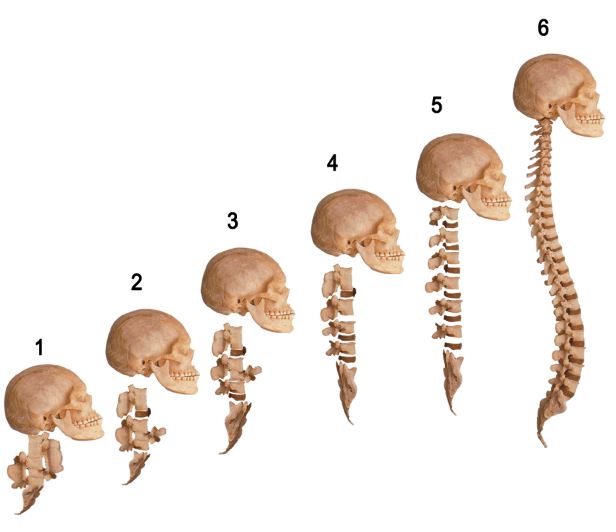 |
| If the stage-by-stage development proposed by evolutionists had actually taken place, then there should have been vertebrates starting with two or five vertebrae, like those above. Yet there is no sign of such species in the fossil record. On the contrary, all the known backbones possess their perfect, present-day forms. |
 |
| 1- A 150-million-year-old Archaeopteryx fossil
2- Archaeopteryx, shown on the left, is claimed by evolutionists to be a transitional form, but has actually been proved to be a fully flying bird. 3- A 410-million-year-old coelacanth fossil
4- The “living fossil” coelacanth, still alive today, is a fully formed fish. The living things that evolutionists maintain represent transitional forms are actually species with complete and flawless structures. They have no transitional characteristics whatsoever. |
Again according to the theory of evolution, chance must have produced hundreds of thousands of transitional forms until arriving at these perfectly formed vertebrae. Until the curved S shape was reached in humans, for instance, there must have been a great many transitional forms, until the point was reached when the backbone would not impact the skull bone. The 33 components of the human backbone could not have come into being suddenly, but would be built stage by stage over thousands of generations. This incremental development, of course, would leave behind at least some traces in the fossil record, and very early fossils with two vertebrae, five vertebrae and twelve vertebrae would be found. However, what actually appears in the record is vertebrates with the most suitable structures and features for the body shape in question. In terms of form and structure, none is deformed, defective, or incomplete. On the contrary, they are perfect. No transitional backbones of the type seen in the pictures below have been encountered anywhere in the fossil record.
All species, living or extinct in the fossil record, are present fully formed and in the most perfect states. The species that evolutionists propose as transitional forms exhibit none of the features of such evolving anatomies. They have no missing or intermediate-stage organs or structures. There are no half-formed or missing features in their skulls, backbones, hands or feet. All living things exist in their most perfect states.
 He created the heavens and the earth with truth.He is exalted above anything they associate with him.He created man from a drop of sperm and yet he is an open challengerl and he created livestock.There is warmth for you in them,and various uses and some you eat.And there is beauty in them [livestock]for you in the evening vhen you bring them home and in the morning when you drive them out to graze. (Surat an-Nahl:3-6) |
There are no fossilized forerunners to dragonflies, owls, fish or squirrels, for instance, in the Earth’s strata. There are no strange fossils vaguely reminiscent of a dragonfly, slightly resembling an owl, or that also bear partial features belonging to other, later species. All these facts demonstrate that the theory of evolution’s claim of living things that developed in stages over millions of years is a complete fantasy. Despite all the studies and quests for proof by evolutionists over roughly the last century and a half, not a single piece of evidence to back up their claims has ever been found.











